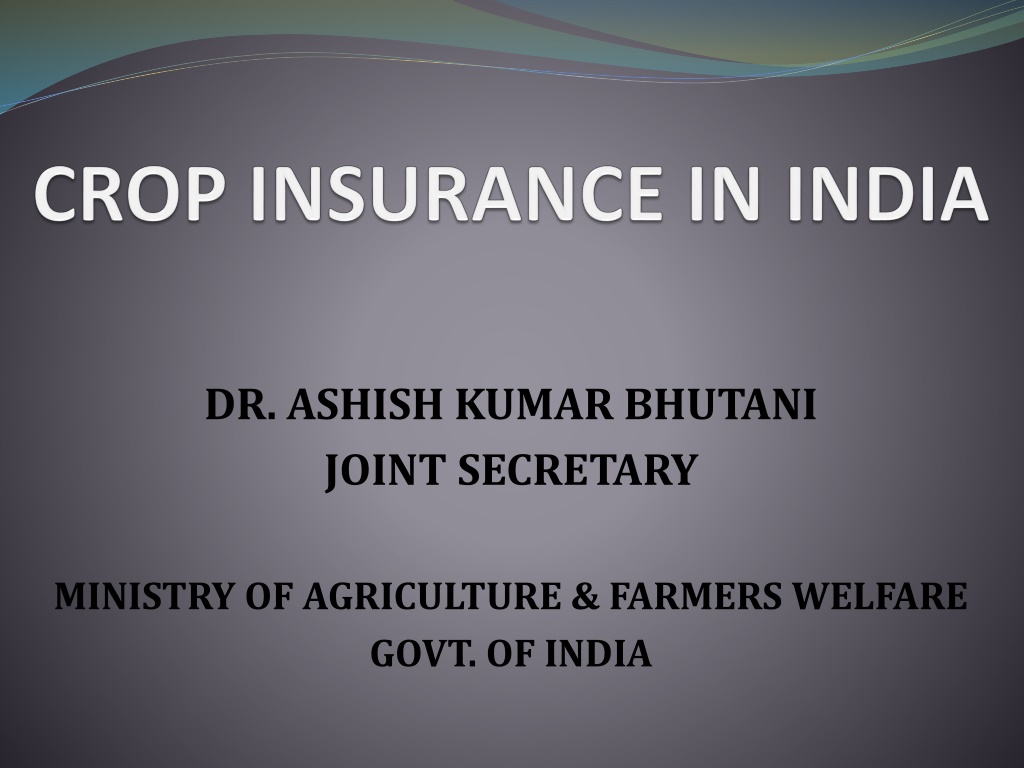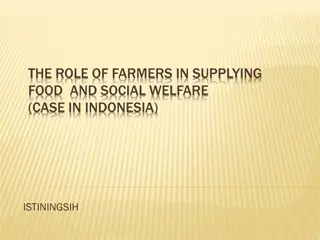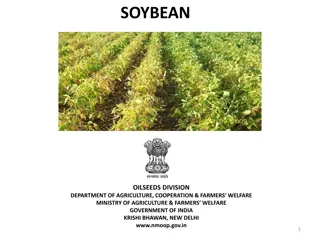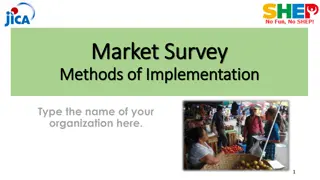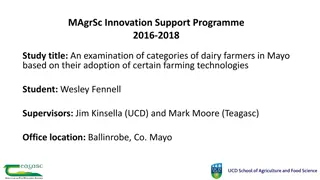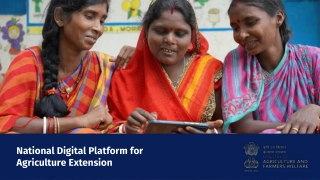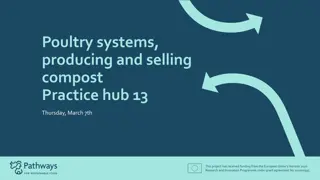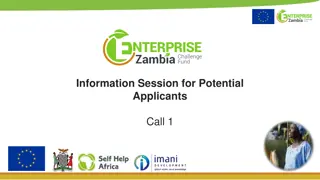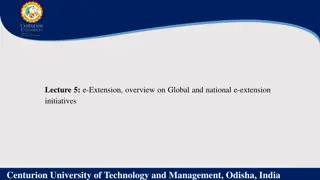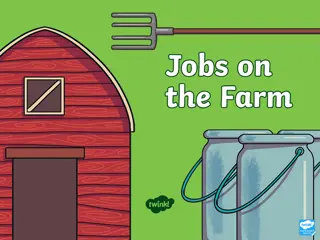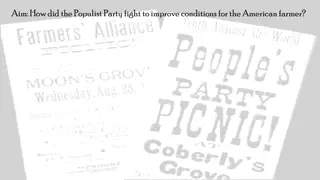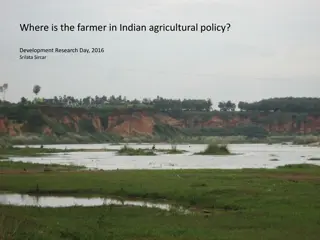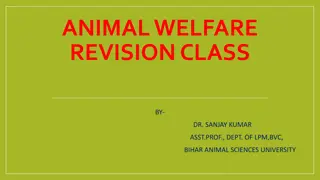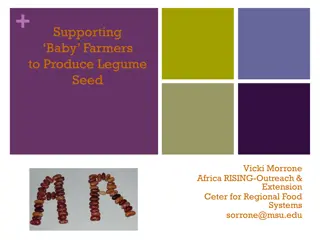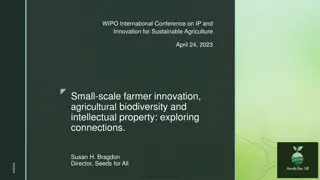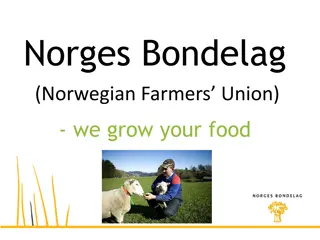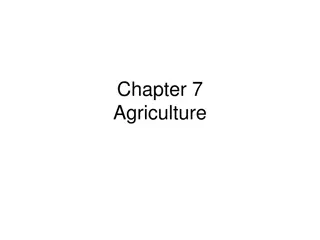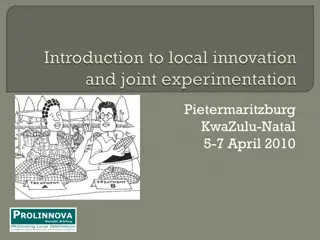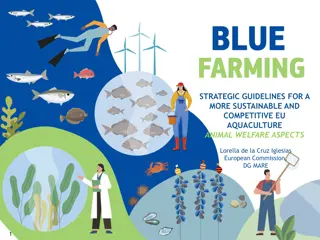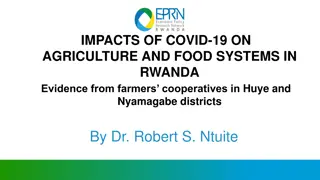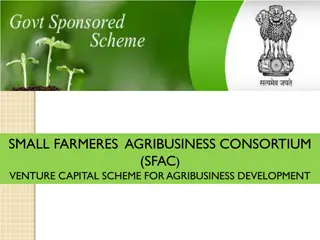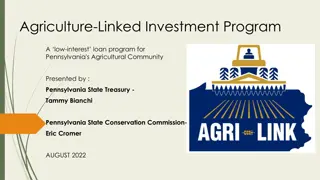Agriculture and Farmers Welfare in India: Overview of Policies and Statistics
This presentation provides insights into agriculture and farmers' welfare in India, covering vital statistics, risks to agriculture, climate change impact, evolution of crop insurance, ongoing schemes, initiatives, country profile, population data, sector-wise GVA share, landholding distribution, crop production, and agriculture loan disbursement.
Uploaded on Sep 28, 2024 | 0 Views
Download Presentation

Please find below an Image/Link to download the presentation.
The content on the website is provided AS IS for your information and personal use only. It may not be sold, licensed, or shared on other websites without obtaining consent from the author. Download presentation by click this link. If you encounter any issues during the download, it is possible that the publisher has removed the file from their server.
E N D
Presentation Transcript
DR. ASHISH KUMAR BHUTANI JOINT SECRETARY MINISTRY OF AGRICULTURE & FARMERS WELFARE GOVT. OF INDIA
STRUCTURE OF PRESENTATION Brief country profile / vital statistics Various risks to agriculture Climate Change, its impact and measures initiated Evolution of crop insurance in India Ongoing Schemes w.e.f. April 2016 (Summer 2016) Features of ongoing schemes New initiatives Statistics on coverage
A BRIEF PROFILE OF INDIA Geographical Area : 329 million hectare (including land area of 306 million hectare) States : 29 Union Territories (UTs) : 7 Districts : 683 Gram Panchayats : 257000 (approx) Villages : 640000 (approx) Net Area sown (2012-13) : 140 mn ha Cropped Area : 194 mn ha Cropping Intensity: 138.92 No. of farmers (land holdings) : 137.75 million (2010-11)
POPULATION (IN MILLION) (CENSUS:2011) Total Urban Rural Cultivators Agl. labours 144.3 1210* 377 833 118.7 (31.2%) (68.8%) AEGR (2001-2011) Density (Person / Sq.km.) Literacy (%) 1.64 382 72.99 *At present : 1300 million (approx).
SECTOR-WISE %AGE SHARE IN GROSS VALUE ADDED (GVA) Sl. No. Sectors 2014-15 (%) 1. 2. 3. Agriculture & Allied Industry Services Total 16.11 31.37 52.52 100
DISTRIBUTION OF LAND HOLDING (Agriculture Census: 2010-11) Categories of Farmers Marginal (<1ha.) Small (1-2 ha.) Semi-medium (2-4 ha.) Medium (4-10 ha.) Large (> 10 ha.) Total No. of holdings (million 92.8 24.7 13.8 5.8 0.97 138.3 Area (million ha.) 35.9 35.2 37.7 33.8 16.9 159.5 Average size (ha.) 0.39 1.42 2.71 5.76 17.38 1.15
PRODUCTION OF MAIN CROPS : 2014-15 (million tonnes) Foodgrains Cereals Pulses Oilseeds Commercial Crops Cotton (million bales of 170kg) Jute & Mesta (million bales of 180kg) Sugarcane Horticulture Crop (2012-13) Fruits Vegetables 252.02 234.87 17.15 27.51 34.81 11.12 362.33 81.28 162.18
LOANS ISSUED TO RAISE AGRICULTURE PRODUCTION : 2014-15 (Short-term crop loan) Crop loan Disbursed (in Rs. million) No. of A/C (farmers) (in million) Category of Banks 11.9 1016660 Cooperatives Banks Commercial Banks 53.3 4574970 08.9 762490 Regional Rural Banks 74.1 6354120 Total 8
VARIOUS RISKS TO AGRICULTURE Vagaries of weather - rainfall (drought / flood) - temperature (high / low) - humidity - wind - cyclone - storm / hailstorm Pest & diseases Landslide Inundation Natural fire and lightening Recent Global Climate Change
GLOBAL CLIMATE CHANGE VIS-A-VIS IMPACT ON AGRICULTURE IN INDIA The Inter-Governmental Panel on Climate Change (IPCC) have been bringing out various assessment reports on climate change since 1990. IPCC has projected 1.8 4.0 degree Celsius increase in temperature by end of this century due to the global atmospheric concentrations of various particles / agents (CO2, CH4, N2O). IPCC also anticipated for more tense tropical cyclones with larger peak wind speed and heavier precipitation. Sea level would rise by 0.18-0.59 meter. Above pattern of climate change would adversely affect the agriculture & allied sectors thereby, food supply. 10
CLIMATE CHANGE : IMPACT ON INDIAN AGRICULTURE Indian Council of Agricultural Research (ICAR) has analyzed the problem and assessed the impact of climate change on agriculture. Reduction in crop yield has been projected for irrigated Maize 18%, irrigated Wheat 6%, irrigated rice 4%, rainfed rice 6% and rainfed Sorghum 2.5% by 2020. Crops identified as risk-prone to climate change are : - Rice & Wheat in Indo-Gangatic Plains, - Rice & Sorghum in rainfed regions, - Kharif Maize in irrigated zones - Potato in West Bengal & Southern plateau region. 11
R & D PROGRAMME / INITIATIVES BY INDIA TO COPE WITH ADVERSE IMPACT OF CLIMATE CHANGE ICAR is implementing an All India Coordinated Research Project on Agro-meteorology (AICRPA) since 1983 to deal with climate change. Government has established National Institute for Aboitic Stress Management (NIASM) during 2009. A network project on National Initiative on Climate Resilient Agriculture (NICRA) was launched in February 2011. 12
EVOLUTION & DEVELOPMENT OF CROP INSURANCE IN INDIA To mitigate the agricultural risks and to provide financial support to farmers against yield losses , Govt. of India (GOI) introduced a Comprehensive Crop Insurance Scheme (CCIS) in 1985 for the first time. Thereafter, efforts have been continuing for development of more farmers friendly products in terms of better services & benefits through incorporating improvements & modifications therein.
PAST COURSE OF CROP INSURANCE IN INDIA Comprehensive Crop Insurance Scheme (CCIS) : 1985 to Summer 1999 (yield index). National Agricultural Insurance Scheme (NAIS): Winter 1999- 2000 to Winter 2015-16 (yield index). Pilot Farmers Income Insurance Scheme (FIIS): Summer 2003 to Winter 2003-04 (yield index). Pilot Weather Based Crop Insurance Scheme (WBCIS): Summer 2007 to Summer 2013 (weather index). Pilot Coconut Palm Insurance Scheme (CPIS): 2009-10 to Summer 2013 (specific crop-based). Pilot Modified NAIS (MNAIS): Winter 2010-11 to Summer 2013 (yield index). National Crop Insurance Programme (NCIP) with component- schemes of MNAIS, WBCIS & CPIS: Winter 2013-14 to Winter 2015-16. 1) 2) 3) 4) 5) 6) 7) 14
ONGOING CROP INSURANCE SCHEMES FROM APRIL 2016 Yield index scheme of Pradhan Mantri Fasal Bima Yojana (PMFBY) has been introduced replacing NAIS & MNAIS. Weather index scheme of WBCIS is continued with change in premium structure & criteria of area allocation - same as PMFBY. Pilot Unified Package Insurance Scheme (UPIS) in 45 districts from April 2016 CPIS continues as under NCIP 15
FEATURES OF ONGOING SCHEME PMFBY Covers all Food crops, Oilseeds & Commercial / Horticultural Crops Compulsory for Loanee & voluntary for non-loanee Risks/perils covered are :- - Area approach: all non-preventable natural risks viz., drought, flood, hailstorm, landslide, cyclone, pests & diseases etc. - Prevented sowing/transplantation: all natural preventable risks - Localized perils: Hailstorm, landslide & Inundation - Post Harvest losses: Cyclone/Cyclonic rain & Unseasonal rains (for crops in cut & spread condition after harvesting)
FEATURES OF ONGOING SCHEME PMFBY CONTD Individual farm level assessment for perils covered under Localized and Post Harvest losses. Sum Insured: Broadly Scale of Finance for loanee & and non-loanee farmers Actuarial Premium Rate Government provides upfront subsidy in premium All claim liability on Insurance Companies Maximum Premium Payable by farmers (as % of Sum Insured):- - For all Food & Oilseeds Crops : Kharif Crops : 2% & Rabi 1.5% - Commercial/Horticultural Crops: 5%
FEATURES OF ONGOING SCHEME PMFBY CONTD Three Indemnity levels (IL) : 70%, 80% & 90% Calculation of Threshold yield which is the average yield of last 7 years (Minus max of 2 calamity years) multiplied by IL Claims calculated on actual yield data furnished by State Govt. based on Crop Cutting Experiments (CCEs).
FEATURES OF ONGOING SCHEME PMFBY CONTD Extensive use of Technology for assessment of loss and to ensure early payment of claims Remote Sensing, Drone, mobile technology etc for accurate & quick estimation of losses Use of Smart phone app for conduction & Transmission of data/information of crop Cutting Experiment (CCEs) An integrated crop insurance Portal for better administration, coordination, transmission of information & transparency Coverage of farmers / cropped area has been set to be increased to 50% from present level of 20% in 2-3 years.
SIMPLIFICATION & EARLY PAYMENT OF CLAIMS Simplification: Formation of cluster of districts for allocation of areas to companies One premium for all crops in a season for farmers Allocation to company for 3 years or more Early Payment of claims: Use of Remote sensing Use of smart phone app in conducting crop cutting experiments & transfer of data on web servers for early calculation of yield data and its accuracy. Better planning, sampling of crop cutting (Intelligent Sampling) Outsourcing of manpower Direct payment of claims amount to insured farmers bank accounts through NEFT 20
FEATURES OF ONGOING SCHEME WBCIS Weather & productivity relationship based product Operates on Area approach linked to a Reference weather station Sum Insured based on cost of cultivation All Crops may be covered including perennial horticulture crops Payouts/claims based on pre-defined triggers on specified weather parameters (rainfall, temperature, wind speed etc.) Claims are calculated based on shortfall/excess in recorded weather parameters with reference to defined trigger values multiplied by notional Sum Insured of each trigger(s)
DEMERITS OF WBCIS High basis risk due to poor density of Automatic weather stations. There is weak correlation between the yield and the weather indices. In WBCIS if a farmer has lost the entire crop at particular stage the compensation given is always less than the maximum sum insured due to peril based sum insured, creating dissatisfaction amongst the farming community. Only weather based risks are covered (Rainfall as single predominant parameter) against AllRisks coverage under NAIS/MNAIS. Risks such as pests, diseases, hailstorms, flooding etc. are not covered. 22
FEATURES OF ONGOING SCHEME UPIS UPIS is being piloted in 45 districts of the country. Single tool to ensure all insurance needs of farmer Category - I: Crop Insurance : PMFBY/WBCIS (compulsory) Category - II: Farmer has to choose at least 2 out of 6 insurance given below: 1. Loss of Life (PMJJBY) 2. Accidental Death & Disability (PMSBY) 3. Student Safety 4. Household 5. Agriculture implements 6. Tractor N.B.: Area based insurance under Crops V/s Individual / assets based insurance.
FEATURES OF ONGOING SCHEME UPIS CONTD To provide comprehensive risk coverage of crops, assets, life, and student safety to farmers To provide all requisite insurance products for farmers through one simple proposal/ application Form. Two flagship schemes of the Government viz. PMSBY & PMJJBY have been included apart from assets. Crop Insurance is implemented on Area Approach. Processing of claims (other than Crop Insurance) on the basis of individual claim report. 24
FEATURES OF ONGOING SCHEME UPIS CONTD Insurance for death / loss of palm or palm becoming un- productive due to natural calamities & un-preventable perils. Individual farmer offering at least 5 healthy nut bearing palms of age of 4-60 years. Coverage is from 4th / 7th year to 60th year, and split into two age groups i.e. 4-15 years and 16-60 years. Sum Insured per palm: Rs. 900/ year for age group 4-15 years and Rs.1750/ year for age group 16-60 years. Premium per palm / year: Rs. 9 for age group 4-15 years and Rs.14 for age group 16-60 years. Subsidy on premium:- 50% by GOI and 25% by States. 25
CHALLENGES IN IMPLEMENTATION OF ONGOING PMFBY/WBCIS/UPIS Due to absence of better technology for estimating the yield, time taking cumbersome method of CCEs is used. Therefore, planning & conducting requisite number of about 6 million CCEs under PMFBY is one of the most challenging task. Under recent global climate changes, making assessment and forecasting rains & other weather conditions in most accurate manner has also become a challenge, which in- turn affecting assessment of yield losses and thereby payment of claims to farmers. Inadequate monetary resources & infrastructure for covering the set target of 50% of farmer households / cropped area in 2-3 years. 26
CHALLENGES IN IMPLEMENTATION OF ONGOING PMFBY/WBCIS/UPIS CONTD Poor density of AWS/ARG and lack of trust among farmers in private AWS/ARG. UPIS: Crop Insurance is seasonal in nature and underwritten on season basis while other products are annual in nature & have to be underwritten annually. UPIS: Crop Insurance is implemented on Area Approach while other risks are on individual claim report basis. Lack of awareness among farmers about the crop insurance schemes and benefits thereof.
NEW INITIATIVES Mahalanobis National Crop Forecast Centre (MNCFC) has been conducting pilots on Remote Sensing Technology (RST) to supplement Crop Cutting Experiments (CCEs) since 2 years. Some States have also been conducting pilots in collaboration with insurance companies and international agencies including World Bank for setting up the protocol of use of RST in supplementing estimation of yield through CCEs. Besides, use of Drones in estimation of yield losses specially due to localized & post harvest perils is also being experimented. 28
NEW INITIATIVES CONTD Web Portal on Crop Insurance (www.agri-insurance.gov.in) launched for better administration, coordination amongst stakeholders, farter information/communication & transparency. An Android based Mobile app on crop insurance has also been developed for getting basic information about insured crops / areas / schemes / insurance companies / Sum Insured / Premium / Govt. subsidy / Threshold yield from any where -any time from any place. Publicity & awareness campaigns have been launched through TV channels, print media etc. transmission of 29
STATISTICS ON CUMULATIVE ACHIEVEMENT (TILL WINTER 2015-16) Schemes/ Items NAIS (Since Winter 1999-2000) WBCIS (Since Summer 2007) MNAIS (Since Winter 2010-11) CPIS TOTAL (Since 2009- 10) 369 Farmers insured ( in million) Area insured (million ha) Premium collected (Rs. In million) 269 72 28 0.076 389 94 30 0.026 513 313008 140093 122712 50169 0.3 Claims paid (Rs. in million) 439853 99167 48042 0.5 587114 135 Farmers Benefited (in million) 78 49 8 0.008
Season Farmers Covered Area Covered Total Premium Total Claims Farmers Benefitted 33 45 42978 74929 16 2012-13 33 43 47542 77229 16 2013-14 37 46 49380 77657 19 2014-15 2015-16 47 53 55808 158436 21
ESTIMATION OF REQUIREMENT OF GOVERNMENT FUNDS (CENTRE +STATES) Particulars 2016-17 2017-18 2018-19 As per earlier Estimates 89180 120620 155000 (In Rs. million) (at 30% coverage) (40% coverage) (50% coverage) Revised Estimates (In Rs. million) 350000 (also includes spillover liability) 240000 300000
COVERAGE OF PRINCIPAL CROPS 2014-15 Insured Area (in Million Hectares) Gross Area (in Million Hectares) Insurance Coverage % SL. No. Crops 1 2 3 4 5 6 7 8 9 10 Paddy Wheat Coarse Grains Sugarcane Cotton Jute & Mesta Oilseeds Pulses Vegetables Fruits Grand Total 42.76 30.50 25.15 5.44 11.90 0.85 29.10 21.96 5.51 3.77 194.40 10.02 7.74 5.95 0.15 1.53 0.07 10.43 5.77 2.09 0.21 45.34 23.43% 25.39% 22.88% 2.67% 12.92% 8.18% 35.84% 26.27% 37.99% 5.58% 23.32% 33
SCHEME-WISE COVERAGE OF CROPPED AREA : 2015-16 Out of Gross Cropped Area of about 195 million ha Yield-based (NAIS & MNAIS) : 37.27 Weather-based (WBCIS) : 9.02 Crop Specific (CPIS) : 0.003 Total : 46.293 34
LIVE STOCK CENSUS: 2012 Sl. No. No Category Population (in million) 1. Cattle 191 2. Buffalo 109 3. Yaks 0.08 4. Mithuns 0.30 5. Bovines 300 6. Sheep 66 7 Goat 135 8 Horses & Ponies 0.63 9 Mules 0.20 10 Donkeys 0.32 11 Camels 0.40 12 Pigs 10 Total Live stock 513
LIVE STOCK INSURANCE Livestock Insurance Scheme was Piloted from 2005-06 to 2007-08 in 100 selected districts. From 2008-09, it is implemented on regular basis in 100 newly selected districts across country through Livestock Development Board of States. Later on, it was extended to 300 districts. Under the scheme, Crossbred & high yielding cattle and buffaloes are insured at market price. Premium was subsidized to 50% by Central Govt. for maximum 2 animals and for maximum 3 years policy. In 2014, Scheme has been modified incorporating more districts and livestock including indigenous cattle, yak & mithun. 36
LIVE STOCK INSURANCE CONTD In 2014, livestock insurance was merged with Centrally Sponsored Scheme Risk Management & Insurance as component of sub-mission on livestock development of NLM. The erstwhile scheme was improved & modified incorporating extended to all animals across the country. Maximum premium rates ranging 3-4% (animal s market price) for 1 year and 7.5-10.5% for 3 year according to area-category (normal/hilly/NE/difficult). Government provide subsidy in premium up to 90% according to area-category. Maximum 5 cattle and 50 small ruminant are insured per household. 37
ACHIEVEMENTS Total number of Animals Amount released by GOI S.No. Year No. of animal Insured (No. in million) (In million) (Rs. in million) 1 2012-13 530* 0.803 458.5 2 2013-14 513# 1.088 475.4 3 2014-15 513# 1.650 248.3 4 2015-16 513# 1.017 113.1 *2007 Census #2012 Census
TARGET POPULATION Milch Small Pack Category Total Animals Animal Ruminant Animal Population 300 211 2 513 (In million) Target Population at only 1/3 of 100 71 0.7 171.7 Animal Population Fund requirement for Premium 38527 27225 10312 990 (In Rs. million) Fund requirement for 100% coverage of animal population 81675 30936 2970 115581 (In Rs. million)
CHALLENGES IN IMPLEMENTATION OF LIVESTOCK INSURANCE IN INDIA Only 0.02% of total animal population is insured at present. To cover 1/3 of animal population, Rs.38527 million of Government support is required but on the other hand, Budgetary support of NLM including LIVESTOCK INSURANCE is only 2920 million during 2016-17. To provide insurance protection to all animals of all farmers in country require huge funds & infrastructure. Inadequate infrastructure with implementing agencies (Insurance Companies) to implement the scheme to all animals of all farmers. Farmers are also not coming forward to insure their animals since the rate of premium is on higher side.
UNIVERSAL AGRICULTURE INSURANCE (UAI) UAI has not yet planned / considered in India. India would require approx Rs. 715581 million for providing insurance to 100% crops and livestock of farmers . Developing countries may be able to afford UAI if insurance cost / burden is shared according to Loss Index and Development Index of the respective country. 41
THANK YOU 42
